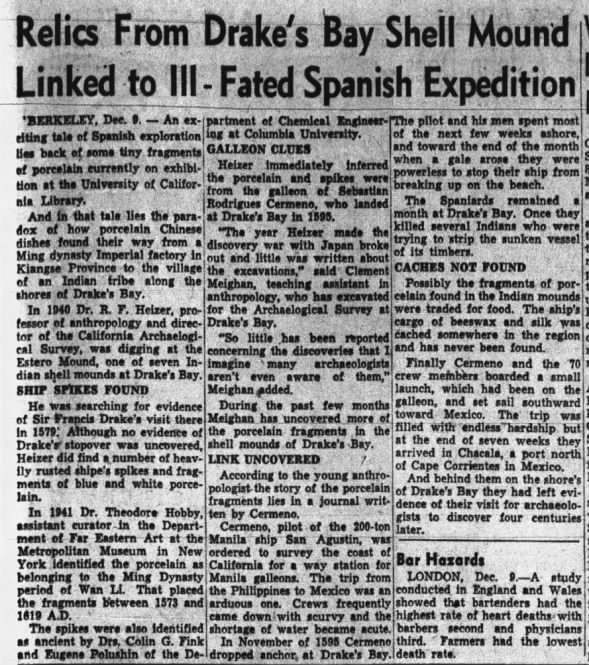Relics From Drake's Bay Shell Mound Linked to Ill-Fated Spanish Expedition
BERKELEY, Dec. 9. - An exciting tale of Spanish exploration lies back of some tiny fragments of porcelain currently on exhibition at the University of California Library.
And in that tale lies the paradox of how porcelain Chinese dishes found their way from a Ming dynasty Imperial factory in Kiangse Province to the village of an Indian tribe along the shores of Drake's Bay.
In 1940 Dr. R. F. Heizer, professor of anthropology and director of the California Archaeological Survey, was digging at the Estero Mound, one of seven Indian shell mounds at Drake's Bay.
SHIP SPIKES FOUND
He was searching for evidence of Sir Francis Drake's visit there In 1579. Although no evidence of Drake's stopover was uncovered, Heizer did find a number of heavily rusted ship's spikes and fragments of blue and white porcelain.
In 1941 Dr. Theodore Hobby, assistant curator in the Department of Far Eastern Art at the Metropolitan Museum in New York identified the porcelain as belonging to the Ming Dynasty period of Wan Li. That placed the fragments between 1573 and 1619 A. D.
The spikes were also identified as ancient by Drs. Colin G. Fink and Eugene Polushin of the Department of Chemical Engineering at Columbia University.
GALLEON CLUES
Heizer immediately inferred the porcelain and spikes were from the galleon of
Sebastian Rodrigues Cermeno, who landed at Drake's Bay in 1595.
"The year Heizer made the discovery war with Japan broke out and little was written about the excavations," said
Clement Meighan, teaching Assistant in anthropology, who has excavated for the Archaeological Survey at Drake's Bay.
"So little has been reported concerning the discoveries that I imagine many archaeologists aren't even aware of them," Meighan added.
During the past few months Meighan has uncovered more of the porcelain fragments in the shell mounds of Drake's Bay.
LINK UNCOVERED
According to the young anthropologist the story of the porcelain fragments lies in a journal written by Cermeno.
Cermeno, pilot of the 200-ton Manila ship San Agustin, was ordered to survey the coast of California for a way station for Manila galleons. The trip from the Philippines to Mexico was an arduous one. Crews frequently came down with scurvy and the shortage of water became acute.
In November of 1595 Cermeno dropped anchor at Drake's Bay. The pilot and his men spent most of the next few weeks ashore, and toward the end of the month when a gale arose they were powerless to stop their ship from breaking up on the beach.
The Spaniards remained a month at Drake's Bay. Once they killed several Indians who were trying to strip the sunken vessel of its timbers.
CACHES NOT FOUND
Possibly the fragments of porcelain found in the Indian mounds were traded for food. The ship's cargo of beeswax and silk was cached somewhere in the region and has never been found.
Finally Cermeno and the 70 crew members boarded a small launch, which had been on the galleon, and set sail southward toward Mexico. The trip was filled with endless hardship but at the end of seven weeks they arrived in
Chacala, a port north of Cape Corrientes in Mexico.
And behind them on the shore's of Drake's Bay they had left evidence of their visit for archaeologists to discover four centuries later.
 Relics From Drake's Bay Shell Mound Linked to Ill-Fated Spanish
Expedition shellmound
10 Dec 1950, Sun
Oakland Tribune (Oakland, California) Newspapers.com
Relics From Drake's Bay Shell Mound Linked to Ill-Fated Spanish
Expedition shellmound
10 Dec 1950, Sun
Oakland Tribune (Oakland, California) Newspapers.com

Comments
Post a Comment